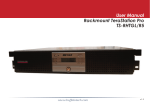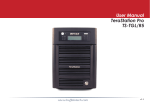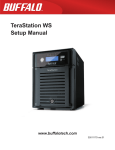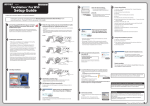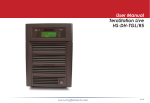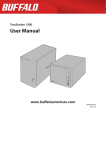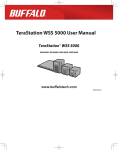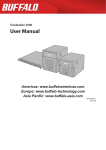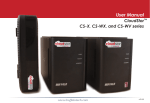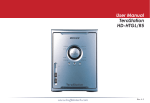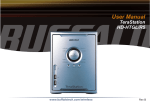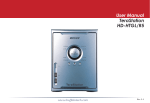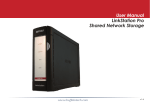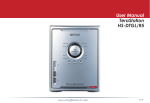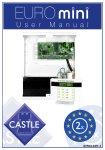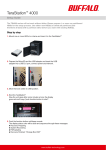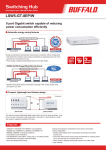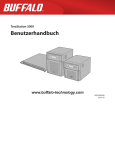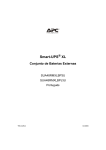Download User Manual TeraStation iSCSI TS
Transcript
www.buffalotech.com User Manual TeraStation iSCSI TS-ITGL/R5 v1.4 Introduction Congratulations on your new TeraStation! Your TeraStation iSCSI is a huge block of iSCSI storage, ready to add to your server or PC via ordinary wired Ethernet connections. This guide will help you configure it. There are many ways to configure and use iSCSI storage products like the TeraStation. In this guide we give one example of configuring a simple iSCSI volume on a single workstation. Many other configurations are usable. Because we’re constantly updating our product, the images and text in this manual may vary slightly from the images and text displayed by your TeraStation. These changes are minor and should not affect the ease of setup adversely. As time passes, future user interfaces, updated software, and later versions of this manual may be available for download at our web site: www.buffalotech.com. If you run into difficulties or need additional help, feel free to contact our technical support. Contact information for Buffalo Technology and our technical support is available on pages 47 and 48. Table of Contents TeraStation Layout............................................................4 Installation........................................................................7 Configuration GUI . ......................................................... 15 Login........................................................................ 16 IP Address................................................................ 20 RAID Settings........................................................... 22 UPS.......................................................................... 27 Alerts........................................................................ 29 Troubleshooting............................................................... 39 Replacing a Hard Drive.................................................... 41 Technical Specifications................................................... 46 Technical Support............................................................ 47 GPL Information.............................................................. 49 Layout Display Mode Switch Power Switch Door opens for access to hard drives. Door Lock (Turn counterclockwise to release) Layout Init Button returns settings to factory defaults. Hard Drives (Squeeze tabs to release) Layout Power Cable (to outlet or surge protector) USB in Ethernet (to NIC, Router, or Switch UPS Installation Begin by connecting your TeraStation’s power and Ethernet cables. The Ethernet cable should be connected to an extra NIC on your server or to a router, hub, or switch on your network. For best performance, all network equipment should be gigabit or better. Use a NIC with enough RJ-45 ports for all your iSCSI devices, or separate NICs for each iSCSI device. Assign static IP addresses for each iSCSI device. Bridge the ports for all the NICs in the server (including the LAN connection). Statically assign the IP address for the LAN to the “Bridged” connection, not on the actual NIC for the LAN. Provided uninterruptable power supplies for all iSCSI devices, as well as the server itself. Simpler configurations may work, but this kind of uncompromising setup is recommended for best performance and reliability. After all connections are made, turn the TeraStation on by pushing the power button on the front panel. It will take about a minute to boot. Insert the TeraNavigator CD into your computer’s CD-ROM drive. On a PC, setup should automatically launch. If it does not, manually launch setup.exe by pressing Start and selecting the Run... option. When the Run dialog opens, type d:\TSnavi.exe (where d is the drive letter of your CD-ROM drive). Press OK to continue. Installation Press the Begin Installation button to begin. Easy Setup will step you through physically connecting your TeraStation. It will then install software. Advanced Setup skips the connection tutorial and goes directly to installing software. Installation If your TeraStation is connected correctly when you get to this window, it will be highlighted in the drop-down list. If you have multiple units to set up, select the correct TeraStation from the list. Select First Setup for the initial installation. To install the software on additional computers, chose Additional Setup. Installation Once the TeraStation is installed, you’ll need to install the iSCSI connection tool. Click Next, then continue to click Next, stepping through the menus until the iSCSI connection tool is installed. Click Yes to launch the iSCSI connection tool. 10 Installation Make sure that your ISCSI TeraStation is selected in the Target product window. Click Register the iSCSI Hard Disk, and then OK. If the TeraStation has more than one volume, choose the volume you want to connect to from the drop down list. Check Resume connection at start up. Click Connect. Repeat to add additional volumes if desired. 11 Installation If Disk Management does not open automatically, you may launch it manually. From the Setup menu at the top of the window, choose Launch Disk Management. Each connected volume from your ISCSI TeraStation now appears as a hard drive in Disk Management. 12 Installation The Initialize and Convert Disk Wizard will open. Use it to convert your new volumes to dynamic volumes. Put a checkmark next to each of your disks and click Next to step through the menu. Right-click on the volume in Disk Management and click New Volume to start the New Volume Wizard. Click Next. 13 Installation Choose your desired volume type. Use Simple if you have only one volume to mount. Spanned and Striped volumes require multiple disk volumes to create. Click Next when ready. Add all dynamic disks that will be included in the volume to the Selected column by highlighting them and then clicking the Add button. 14 Installation Choose your desired drive letter. Click Next. Choose your desired format and volume label. Click Next. Your new volume is installed and ready to use! 15 Configuration GUI The Configuration GUI is where most of the TeraStation’s settings can be changed. To access it, type the IP address of your TeraStation into the URL bar of a browser running on a computer connected to the same network as the TeraStation. 16 Advanced Settings The login prompt will appear. Enter admin for the user name. Until you change it, the password for the admin account will be password. Press the OK button when finished. User name: admin Password: password 17 Configuration GUI Welcome to the configuration GUI for the TeraStation! You are now at Home. Notice that the Home button is lit up in yellow. You can navigate this menu by clicking on the buttons at the left of the screen. Here at “Home”, you can see basic information about your TeraStation’s current configuration. You may close this screen by clicking Logout at the bottom left, or just by closing the browser window. If you have lost your TeraStation, clicking I’m here! at the bottom left will cause it to beep, making it easier to find. Note that many settings cannot be changed while the iSCSI service is running. Click the button in the top left corner of the page to disable the iSCSI service if settings need to be changed. 18 Configuration GUI Basic You may modify your TeraStation’s hostname and description under Hostname Setup. A friendly, easy-to-remember name (e.g. “TeraStation”) is recommended. Make sure that the date and time are correct in Date and Time Setup. To synchronize time settings with those in your computer, press Use Local Time. To have your system time automatically set by an NTP server, enable NTP Server and enter an IP Address for the NTP server (e.g. 192.43.244.18) or use the supplied default NTP server. Ensure that both the Display Language and the Windows Client Language are set to languages that you’re comfortable with. Once desired fields have been completed, press the Apply button. 19 Configuration GUI Admin Password By default, the admin password is “password”. Change it to something more secure here. 20 Configuration GUI Network (IP Address Properties) In most networks, TeraStation will get its IP Address automatically from a DHCP server. You may disable DHCP here. If DHCP is disabled and an IP Address is not set manually, it will default to 192.168.11.150. The TeraStation’s IP Address, Subnet Mask, Default Gateway Address, and DNS Server address may all be entered manually under IP Address Properties. Ethernet Frame Size may also be set manually on this page. Only use JumboFrame settings when operating in a Gigabit environment where all other clients support the same JumboFrame setting. Click Apply after making any changes. 21 Configuration GUI Disk Management (Drive Properties) This page shows the current properties of your hard drives and RAID Arrays. To change these settings, click on RAID Setup at left. 22 Note on RAID Arrays TeraStation uses RAID (“Redundant Array of Independent Disks”) technology to control the four hard drives in your TeraStation. RAID may be configured several ways: RAID 0 - All four drives are combined into one large, fast drive, giving the maximum capacity for your TeraStation. This size is the one listed on your TeraStation’s box and shows the total capacity of the TeraStation with no data used for redundancy. RAID Spanning is fast and efficient, but with no redundancy, if one hard drive fails, all data on the TeraStation is lost. RAID 1 (mirroring) - Hard drives are arranged in mirrored pairs. Each half of the pair reads and writes exactly the same data. This costs you half the total capacity of the array, but provides excellent redundancy. If a hard drive fails, the mirror continues to supply data, so you may work on normally. You may replace the damaged or defective drive at any time, and normal RAID 1 mirroring will then be automatically restored. RAID 5 (parity) - All drives in a RAID 5 array reserve part of their data space for parity information, allowing all data to be recovered if a single drive fails. The parity information takes up about one hard drive’s worth of space, so if you set up all four drives in the TeraStation as a RAID 5 array, your usable capacity will be about 3/4 of the total capacity of the TeraStation. This is how your TeraStation is set up out of the box. RAID 10 - Combines RAID 1 and RAID 0 for a fast, secure array. Half of the TeraStation’s total capacity is used for redundant information. Buffalo Technology recommends RAID 5 for its excellent balance of efficiency and security. 23 Configuration GUI Disk Management (RAID Setup) This page shows your current RAID arrays. You may delete old arrays or create new ones by clicking on the underlined RAID Array # under RAID Array Configuration. The RAID Scanning Settings set a specific time for the TeraStation to scan and inspect its RAID arrays. It is recommended to set a time where the TeraStations usage will be minimal (perhaps the middle of the night). TeraStation will be significantly slower while the RAID scan occurs. Begin Immediate RAID Scan specifies the TeraStation to run a RAID Scan immediately. You may also disable RAID Array Error Detection Response from this page. Normally, this is set to automatically shut down the RAID array when an error is detected. Though it is not recommended, you may disable that behavior by selecting Disable. NOTE: TeraStation has four internal hard drives. Before creating a new RAID array, you may have to delete one or more pre-existing RAID Arrays to clear up the hard drives for your new one. This will destroy all data currently on the disks, so back up any important data before deleting RAID arrays. Whether you want to clear out an old array or create a new one, begin by clicking on the array’s underlined RAID Array #, under Name. 24 Configuration GUI Disk Management (Disk Erase) Disk Erase removes all data from the selected disk. This may take several hours to complete. It cannot be undone. 25 Configuration GUI Volume Settings Here you can enable or disable volumes, shares, and folders. 26 Configuration GUI Maintenance (Notification) If your TeraStation is remotely managed, you may choose to receive nightly status reports and be notified of any disk events by email. To set this up, enable Mail Notification and enter the IP Address of your SMTP server* in the SMTP Server Address field. Select a Subject line for the emails (i.e. “TeraStation Status Report”) and enter the email address of each person you want to receive notification emails into a Recipient Mail Address field. 27 Configuration GUI Maintenance (UPS Settings) You may enable Synchronize with UPS and UPS Shutdown Conditions from this page. Consult your Uninterruptable Power Supply’s documentation for further information about setting up your UPS system. Buffalo Technology recommends the use of APC SmartUPS Serial Uninterruptable Power Supplies. Other UPSs may use different pin configurations. Compatibility cannot be guaranteed with other UPSs. Turn to the next page for more on the TeraStation’s UPS serial port. 28 UPS Configuration Maintenance (UPS Settings) This is TeraStation’s serial port pin assignment for serial UPS products. 29 Configuration GUI Maintenance (Alert Settings) Alerts can be configured on the TeraStation to make audible noises when a problem is detected. Along with the audible noise, alert emails will be sent out if Mail Notification was properly configured. Please select the features you would like to receive an audible sound alert from and then press the Apply button. 30 Configuration GUI Maintenance (Status LCD) The Status LCD Setup allows configuration for the LCD display on the front of TeraStation. Please select the type of information that the front panel should display from the LCD Display Items. Automatically Switch LCD Items tells the TeraStation to cycle through the selected display items every 10 seconds. Disabling this feature means the LCD display does not cycle, and it will stay on the same display item until the Display button on the front of TeraStation is pressed. The LCD screen and green LED buttons brightness can be controlled via their respective settings. Press the Apply button once all of the settings have been configured. 31 Configuration GUI Maintenance (Syslog Transfer) Check Enable to allow system logs to be transferred. Press Apply once all of the settings have been configured. 32 Configuration GUI Maintenance (Shutdown) From the Shutdown page, press Apply to shutdown TeraStation. This has the same function as holding down the power button on the front of TeraStation, but may be done remotely. Turning on the TeraStation after a shutdown requires a physical button push on the front of TeraStation. The Restart Now button simply reboots the TeraStation, bringing it back to functionality after about 120 seconds. 33 Configuration GUI Maintenance (Initialization) Initialization is a reset procedure that restores all settings back to the default, out of box, configuration. All configuration, users, groups, and backup jobs are lost, but actual data and shares on the hard are NOT lost. If you want all data to be erased, reformat the drive. Specify whether the TeraStation shall keep its administrator password after a initialization or whether the password should be reset to the default password (default password is password). Press the Apply button once you make the selection. Press the Restore button to begin the initialization process; this will restore all settings to factory defaults but does NOT erase the data on the hard drives. 34 Configuration GUI This page shows you the System Information for your TeraStation. Firmware updates are occasionally available from www.buffalotech.com for the TeraStation Pro. These must be executed from a Windows PC on the same network. Your router, switch, or hub should pass through ports 8873 and 22939 for this to work (most do). 35 Configuration GUI System Status (USB Details) This page shows you details on USB hard drives and UPSs plugged into your TeraStation. 36 Configuration GUI System Status (Drive Properties) This page shows you the properties of all hard drives and RAID arrays in and attached to your TeraStation. 37 Configuration GUI System Status (Network Information) This page shows you the System Information for your network connection. 38 Configuration GUI Log Information This page lets you save or display system log information. Choose the log you want from the Log Type dropdown and click Save. The dialog will let you save or display (“Open”) the logfile. 39 Troubleshooting If TeraStation encounters a disk error, it will be reported in the TeraStation status on the top of any of the Web-Based configuration screens. Run a Disk Scan in the event of this error. If that does not resolve the problem, a format is recommended. Formatting the drive will delete all of the data on it, so back up any data you can before formatting. Finally, if none of the above solutions help, then please contact Technical Support (see pages 73 and 74 for Technical Support contact information). 40 Troubleshooting DIAG LCD Codes: Error Code E00 E01 E02 E03 E04 E10 E11 E12 E13 E14 E15 E16 E17 E18 E19 E20 E21 E22 E23 Description Alert MPU error: Main MPU is not responding. Error on DRAM DATA LIN Error on DRAM ADDRESS LINE Error on RTC CHIP Failed to load kernel (FLASH error) UPS AC LINE FAIL Error FAN Error: Fan rotation speed is low or fan is stopped. Cooling Error: Cooling by fan cannot catch up. Error has occurred on RAID Array x. Cannot mount RAID Array x. Not Used Cannot find HDDx. Cannot communicate with RTC chip (IC12). Cannot communicate with SATA chip (IC1). Cannot communicate with SATA chip 2 (IC2) Cannot communicate with USB chip (IC5) Cannot communicate with Ethernet chip (IC13) Cannot mount HDDx HDDx faulty (HDDx is excluded from raid because of errors) 41 Sound A A A A A B B B B B B A A A A A B B Replacing a Hard Drive Turn the key counter-clockwise to open drive door. Squeeze the tabs gently and swing the tray latch upward. The hard drive tray will now slide out. 42 Lower the drive carefully to the work surface. Gently push down on the two tabs to release the plug. 43 Pull the plug straight out to remove the drive. To remove the hard drive from its cage, set the assembly on a soft surface and remove these four screws. 44 Install a new hard drive by doing the same steps in reverse order: Begin by screwing the new hard drive into the cage. Plug the power/data connector into the hard drive. Slide the hard drive cage back into the TeraStation. Press the latch down to lock the hard drive cage in place. 45 Technical Specifications LAN Standards: IEEE 802.3u 100BASE-TX; IEEE 802.3 10BASE-T Transmission Types: 1000Mbps/100Mbps/10Mbps; 100BASE-TX 4B/5B, MLT-3;10BASE-T Manchester Coding Access Media: CSMA/CD Media Interface: RJ-45 USB Standard: USB 2.0 Hi-Speed (HS) Full-Speed (FS) Low-Speed (LS) USB Connector: USB A Connector (2) Data Transmission Speed: Max: 480 Mbps (HS Mode) Max: 12 Mbps (FS Mode) UPS: UPS Compatible (Serial/USB connection) Power Consumption: ~56W (Varies based on size) Dimensions: 6.7” x 9.3” x 12.2” (170 x 235 x 310 mm.) Weight: ~15.8 lb (7.2 kg) (Weight varies based on size) Operating Environment: 32° - 95° F; 20-80% non-condensing 46 Contact Information (North America) Buffalo Technology USA Inc. 11100 Metric Blvd, Suite 750 Austin, TX 78758 GENERAL INQUIRIES Monday through Friday 8:30am-5:30pm CST Direct: 512-794-8533 | Toll-free: 800-456-9799 | Fax: 512-794-8520 | Email: sales@ buffalotech.com TECHNICAL SUPPORT North American Technical Support by phone is available 24 hours a day, 7 days a week. (USA and Canada). Toll-free: (866) 752-6210 | Email: info@buffalotech.com 47 Contact Information (Europe) Buffalo Technology UK Ltd. 2 Bracknell Beeches, Old Bracknell Lane Bracknell, Berkshire, SL1 4RD United Kingdom GENERAL INQUIRIES Email: sales@buffalo-technology.com TECHNICAL SUPPORT Buffalo Technology provides technical support in English, German, French, Italian, and Spanish. For opening hours and relevant telephone numbers, please go to www.buffalo-technology.com/contact 48 GPL Information (North America) Thank you for your interest in Buffalo products. Our GPL software delivery policy is outlined below. For each individual product and revision, please send one individually packaged self addressed padded CD shipping envelope, containing a blank CD-R to the following address: Buffalo Technology USA Inc. 11100 Metric Blvd., Suite 750 Austin, TX 78758 Attn. GPL Department Within the envelope containing the self addressed padded CD shipping envelope, please include a bank draft or money order for $20 (USD) (Made out to: Buffalo Technology) to cover our handling fee, postage and CD preparation. The CD-R should have the name of the product and revision number clearly written on the actual CD-R (not on the insert). We do not send GPL source in bulk on a DVD. And order confirmation is not required by the GNU General Public License. We are more than happy to comply with your request; however, we must ask you to comply with our GPL distribution policy, which complies with the GNU General Public License. Sincerely, Buffalo Technology GPL Department 49 GPL Information (Europe) Thank you for your interest in Buffalo products. Our GPL software delivery policy is outlined below. For each individual product and revision, please send one individually packaged self addressed padded CD shipping envelope, containing a blank CD-R to the following address: Buffalo Technology Ireland Ltd Free Zone East, Shannon, Co. Clare Ireland Attn. GPL Department Within the envelope containing the self addressed padded CD shipping envelope, please include a bank draft or money order for €20 (Euro) (Made out to: Buffalo Technology) to cover our handling fee, postage and CD preparation. The CD-R should have the name of the product and revision number clearly written on the actual CD-R (not on the insert). We do not send GPL source in bulk on a DVD. And order confirmation is not required by the GNU General Public License. We are more than happy to comply with your request; however, we must ask you to comply with our GPL distribution policy, which complies with the GNU General Public License. Sincerely, Buffalo Technology GPL Department 50


















































